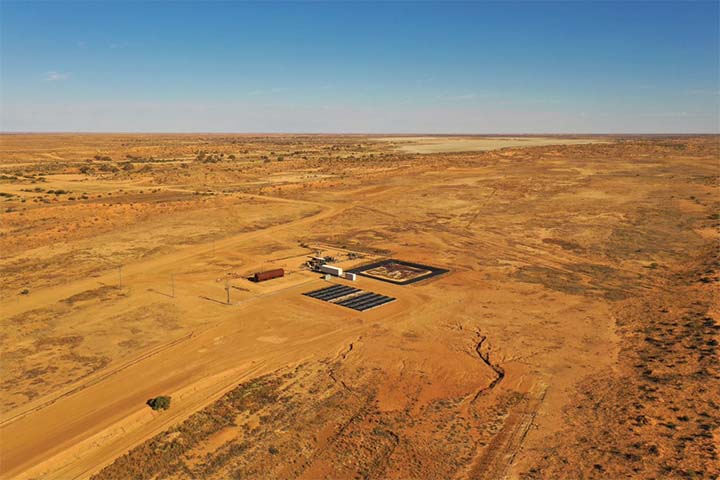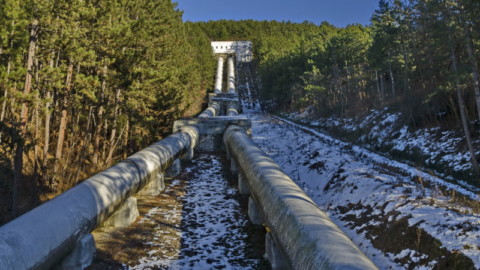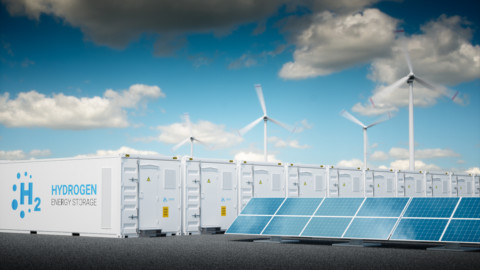by Christine Corbett, Chief Customer Officer, AGL
Spanning the borders of north-east South Australia and south-west Queensland, it’s mostly red desert as far as the eye can see, but you will also find the Cooper and Eromanga Basins which house Australia’s largest onshore oil and gas field development operated by Santos. As businesses seek more sustainable ways to operate and decarbonise, Santos partnered with AGL to find a renewable way to power 12 remote oil well pump motors.
From working in an isolated location, to experiencing extreme weather events and managing an evolving pandemic, the project had unprecedented challenges, but AGL found the perfect solution through the development of a hybrid microgrid.
Challenges of a remote location
When AGL’s sustainable business energy solutions team began work on the project, one of the biggest challenges was creating a system that would perform in such a remote location.
Deep in the South Australian desert, the Charo oil field is a three-hour drive from the company town of Moomba, which operates a small regional airport with limited incoming flights. For personnel travelling by road, Moomba is a minimum two-day drive from Adelaide.
Once on-site, the vast and desolate environment of the Cooper Basin sinks in, with the area experiencing extreme heat with temperatures up to and in excess of 400C. But, AGL’s team was up for the unique challenge.
AGL’s Chief Customer Officer, Christine Corbett, has been with the organisation since 2019 and during this time has expanded AGL’s commitment to finding smarter sustainable solutions for customers.
Stepping into her role with a customer-centric mindset, Ms Corbett has been an advocate for improving the experience of all AGL customers, big and small. Ms Corbett said in the early stages of the project, the team had to think outside the box to assess how they would be able to construct this micro-grid in such a remote location of Australia.
“For this project, our team was comprised of project managers and engineers who were experienced in working remotely and in harsh weather conditions,” Ms Corbett said.
“With a site only accessible by a challenging dirt road and in an area that can see extensive flooding, it was crucial we had the right people working together.”
Each worker on site was specialised in remote-area work for extended periods of time and working in demanding conditions that require psychological management, high safety precautions and preparedness for summer heat stress.
“Within an environment like the Cooper Basin, team members become teammates – looking out for each other and prioritising safety.” Ms Corbett said
Collecting crucial data
The AGL team started the project with limited information on the current operations or historical power usage of the oil pump motors. This data is a crucial piece to the puzzle in these projects, in order to understand how the motors were operating.
To overcome this gap the AGL engineers model how the microgrid would operate once commissioned, using data loggers which allow the current operations to be examined. “The sheer remoteness of the site, combined with obtaining granular data on its current power usage, was a challenging task,” Ms Corbett said.
As this data was gathered, reviews of the oil pump energy demands revealed the highly dynamic nature of the electrical loads that could fall to low levels and increase to high levels in the space of a few seconds.
This potential rapid change provided AGL with the insight it needed to design and construct the optimal microgrid. “From here the team was able to develop a sophisticated engineering solution by undertaking a series of studies to inform the system design and ensure that the microgrid would be fit for purpose,” Ms Corbett said.
“We know that no two businesses or projects are the same, with varying needs and requirements from solar and energy-efficient lighting to power factor corrections and operating solutions, and this project was one of the most unique the team has done to date.”

As well as a centralised solar PV system, the hybrid microgrid was made from a Battery Energy Storage System (BESS) and generators connected to the motors via 6km of high-voltage power lines.
A hybrid solution
For this project, constructing a hybrid microgrid solution was the key to supplying power to a remote area that is largely unsupervised. With nearby well sites, it was advantageous to supply the sites from a single point via high voltage transmission.
By using multiple power sources in the microgrid, the AGL team has prepared Santos for inclement weather events that have the potential to disrupt one power source, like cloud cover disrupting solar. Further, the supervisory control and data acquisition (SCADA) system was installed as part of the microgrid to assist in remote monitoring and control, reducing the potential need for site visits.
“The hybrid microgrid was an excellent solution for Santos and supported their goal to lower emissions and operating costs while continuing to support the powering of the oil well pump motors,” Ms Corbett said.
The microgrid consisted of a centralised solar PV system, a Battery Energy Storage System (BESS), and generators connected to motors via high-voltage power lines. The new system would improve efficiency, reduce maintenance time and fuel, while decarbonising by introducing renewable energy into the power generation.
Each facet of the microgrid complemented the other; gensets to provide baseload energy, the battery to manage load dynamics to help generators maintain fuel efficiency, the PV charges the battery during the day to reduce the load on the generators, a control system, and SCADA to ensure the effective management of site loads by dictating how and when the equipment operates.
The microgrid was also designed with a modern automatic control system that is capable of managing the dynamics of electrical loads, diagnosing faults, and optimising the system’s operations.
“More than 12,000 work hours later, the team had in place a distributed energy resource that will create an efficient and sustainable solution for Santos and a great example of what can be done for other energy-intensive businesses,” Ms Corbett said.
Prototyping specialised microgrids
While there are other microgrids operating in Australia, this project is innovative, acting as a prototype microgrid that is specialised for the dynamic well-lease load requirements. As a unique and specialised solution, microgrids are not a one-size-fits-all concept, but rely on a design that manages elements and environmental factors specific to that project.
In this case, the remoteness of the Cooper Basin meant that AGL’s microgrid needed to have the capacity to manage loads throughout the day in extreme conditions. By ensuring the microgrid was capable of this, AGL has enabled Santos to maintain the production of its oil wells.
Over time, the microgrid will be fine-tuned to meet potential climatic changes of the site and to sub-surface well-lease reservoir conditions. This process will allow AGL and Santos to collaboratively tweak the microgrid, potentially improving the system’s performance.
“We are committed to using the latest technologies and innovations to create distributed energy resources which support big and small businesses,” Ms Corbett said. “Our work with Santos has extended over four years with 55 completed projects in the Cooper Basin, providing them with energy solutions to further their business and improving both the commercial performance and environmental impact of its operations.
“This work has helped Santos shift to sustainable energy sources, utilising battery energy storage systems and ground-mount solar PV systems integrated with Santos’ existing gensets.
“As the largest ASX investor in renewables we are committed to helping all businesses reach their decarbonisation goals while ensuring their operations remain viable and affordable well into the future.”



















